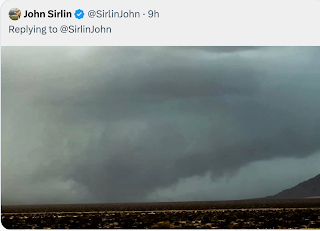You Read It Here First
We now have yet another peer-reviewed paper that ties the recent arctic and glacier ice melting to dust rather than temperatures. You've read that contention on this blog here, here, and here just to provide three of the numerous examples.
MIAMI — A University of Miami (UM) Rosenstiel School of Marine and Atmospheric Science-led study shows a link between large dust storms on Iceland and glacial melting.
The dust is both accelerating glacial melting and contributing important nutrients to the surrounding North Atlantic Ocean. The results provide new insights on the role of dust in climate change and high-latitude ocean ecosystems.
Glad to see these findings confirmed elsewhere.
Hat Tip: Anthony Watts, WattsUpWithThat




Since dust/fine dust/particle emissions is used as a major tool to ban fossil fueled city traffic from our modern city centers forcing communities, business and private citizens to perform major investments in low emission vehicles I have been observing the subject of dust closely.
ReplyDeleteIn Germany for example the introduction of Green Zones has not resulted in reduction of particles at all.
Dust is mainly a natural phenomena. Most of the dust we see near glaciers is produced by glaciers when the moving ice crunched the rocks. We have huge deserts and many volcano's that that feed the atmosphere and our oceans with dust.
Human induced dust and particles, from agriculture, industry, construction, traffic is relative small.
We see this in the measurements in Europe where a great deal of the dust collected comes from the Sahara desert.
Depending on the timing of the season, we also see bio particles from plants and trees and even spider eggs.
The fact that the Green Zones in Germany show no dust reduction tells me we are dealing with a non problem.
Now from observations:
Two years ago we had the Iceland volcanic eruption that buried glaciers and ice caps with a thick layer of dust.
Instead of triggering ice melt this dust functioned as an insulator preserving the the ice through out the summer.
Obeservations from other active volcanic sites confirm this observation and it's also confirmed by the ice cores.
Glacier melt should be called glacier evaporation.
Just do the test yourself. Put a few ice cubes in your fridge. Despite freezing temperatures the ice will be gone after a few days. So precipitation play's a much bigger role here.
Dust has been a factor even before humans roamed the planet and we should be very careful with any report that makes a connection between ice melt and human activity or even ice melt in general where no ice melt is taking place at all.
Especially now we know that the UN has prepared an environmental constitution that will end a perfectly fine civilization for good.
http://endoftheamericandream.com/archives/proposed-un-environmental-constitution-for-the-world-would-establish-an-incredibly-repressive-system-of-global-governance